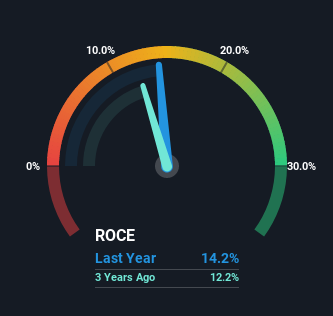Manali Petrochemicals (NSE:MANALIPETC) Is Reinvesting At Lower Rates Of Return

Did you know there are some financial metrics that can provide clues of a potential multi-bagger? One common approach is to try and find a company with returns on capital employed (ROCE) that are increasing, in conjunction with a growing amount of capital employed. This shows us that it's a compounding machine, able to continually reinvest its earnings back into the business and generate higher returns. However, after briefly looking over the numbers, we don't think Manali Petrochemicals (NSE:MANALIPETC) has the makings of a multi-bagger going forward, but let's have a look at why that may be.
Return On Capital Employed (ROCE): What Is It?
Just to clarify if you're unsure, ROCE is a metric for evaluating how much pre-tax income (in percentage terms) a company earns on the capital invested in its business. To calculate this metric for Manali Petrochemicals, this is the formula:
Return on Capital Employed = Earnings Before Interest and Tax (EBIT) ÷ (Total Assets - Current Liabilities)
0.14 = ₹1.6b ÷ (₹13b - ₹1.7b) (Based on the trailing twelve months to December 2022).
So, Manali Petrochemicals has an ROCE of 14%. In absolute terms, that's a pretty normal return, and it's somewhat close to the Chemicals industry average of 17%.
Check out our latest analysis for Manali Petrochemicals

Historical performance is a great place to start when researching a stock so above you can see the gauge for Manali Petrochemicals' ROCE against it's prior returns. If you're interested in investigating Manali Petrochemicals' past further, check out this free graph of past earnings, revenue and cash flow.
What Does the ROCE Trend For Manali Petrochemicals Tell Us?
On the surface, the trend of ROCE at Manali Petrochemicals doesn't inspire confidence. To be more specific, ROCE has fallen from 21% over the last five years. And considering revenue has dropped while employing more capital, we'd be cautious. This could mean that the business is losing its competitive advantage or market share, because while more money is being put into ventures, it's actually producing a lower return - "less bang for their buck" per se.
On a related note, Manali Petrochemicals has decreased its current liabilities to 13% of total assets. That could partly explain why the ROCE has dropped. Effectively this means their suppliers or short-term creditors are funding less of the business, which reduces some elements of risk. Since the business is basically funding more of its operations with it's own money, you could argue this has made the business less efficient at generating ROCE.
In Conclusion...
In summary, we're somewhat concerned by Manali Petrochemicals' diminishing returns on increasing amounts of capital. Yet despite these poor fundamentals, the stock has gained a huge 114% over the last five years, so investors appear very optimistic. In any case, the current underlying trends don't bode well for long term performance so unless they reverse, we'd start looking elsewhere.
On a final note, we've found 1 warning sign for Manali Petrochemicals that we think you should be aware of.
While Manali Petrochemicals isn't earning the highest return, check out this free list of companies that are earning high returns on equity with solid balance sheets.
New: Manage All Your Stock Portfolios in One Place
We've created the ultimate portfolio companion for stock investors, and it's free.
• Connect an unlimited number of Portfolios and see your total in one currency
• Be alerted to new Warning Signs or Risks via email or mobile
• Track the Fair Value of your stocks
Have feedback on this article? Concerned about the content? Get in touch with us directly. Alternatively, email editorial-team (at) simplywallst.com.
This article by Simply Wall St is general in nature. We provide commentary based on historical data and analyst forecasts only using an unbiased methodology and our articles are not intended to be financial advice. It does not constitute a recommendation to buy or sell any stock, and does not take account of your objectives, or your financial situation. We aim to bring you long-term focused analysis driven by fundamental data. Note that our analysis may not factor in the latest price-sensitive company announcements or qualitative material. Simply Wall St has no position in any stocks mentioned.
About NSEI:MANALIPETC
Manali Petrochemicals
Manufactures and sells petrochemical products in India, the United Kingdom, and internationally.
Excellent balance sheet average dividend payer.
Market Insights
Community Narratives




